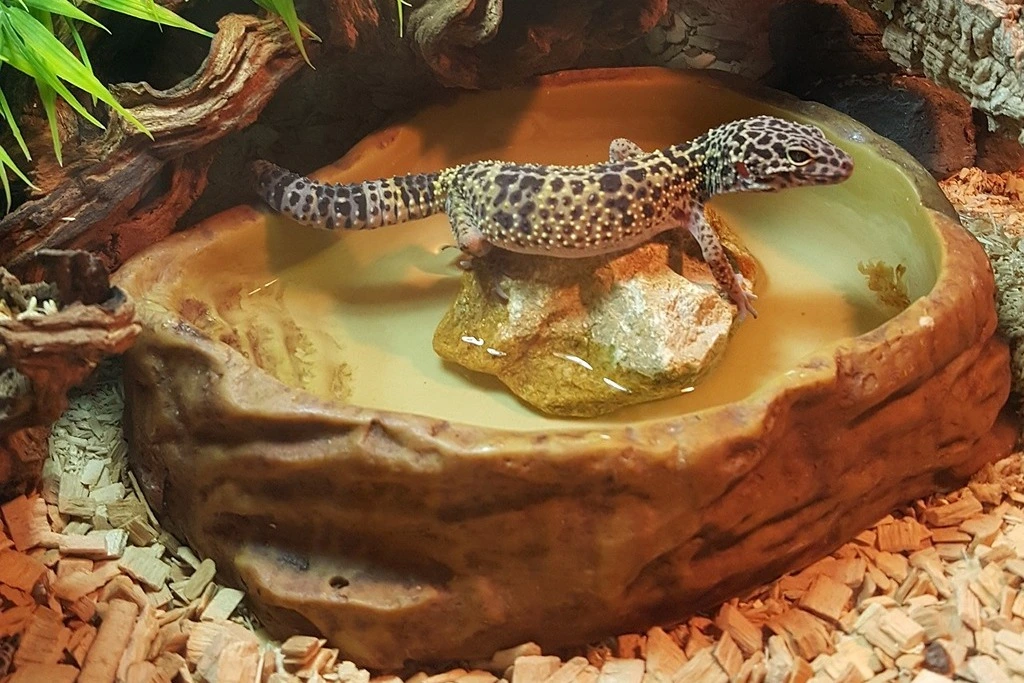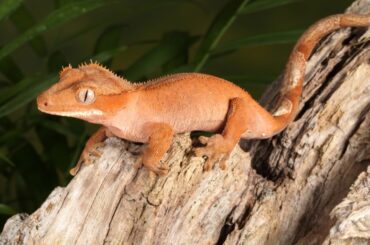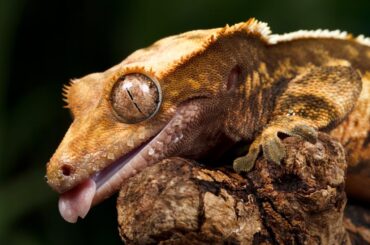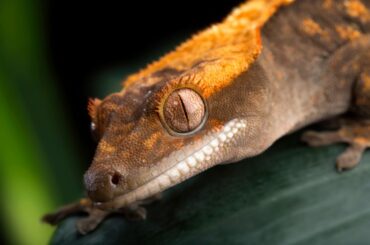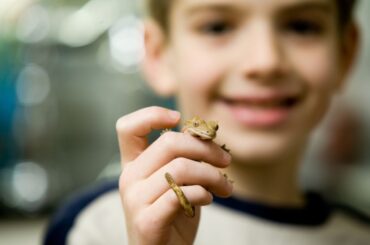Dehydration is dangerous for both humans and animals. The leopard gecko is no different. You can lessen your leopard gecko’s likelihood of dehydration by being aware of the symptoms and causes.
Leopard geckos experience dehydration when they don’t have access to the water they require for drinking or washing. Your pet’s general health depends on proper hydration.
Giving your pet access to clean water for drinking and washing is crucial. Once to twice a week, adult leopard geckos may have their enclosure misted.
What Are the Signs That Your Leopard Gecko Is Dehydrated?
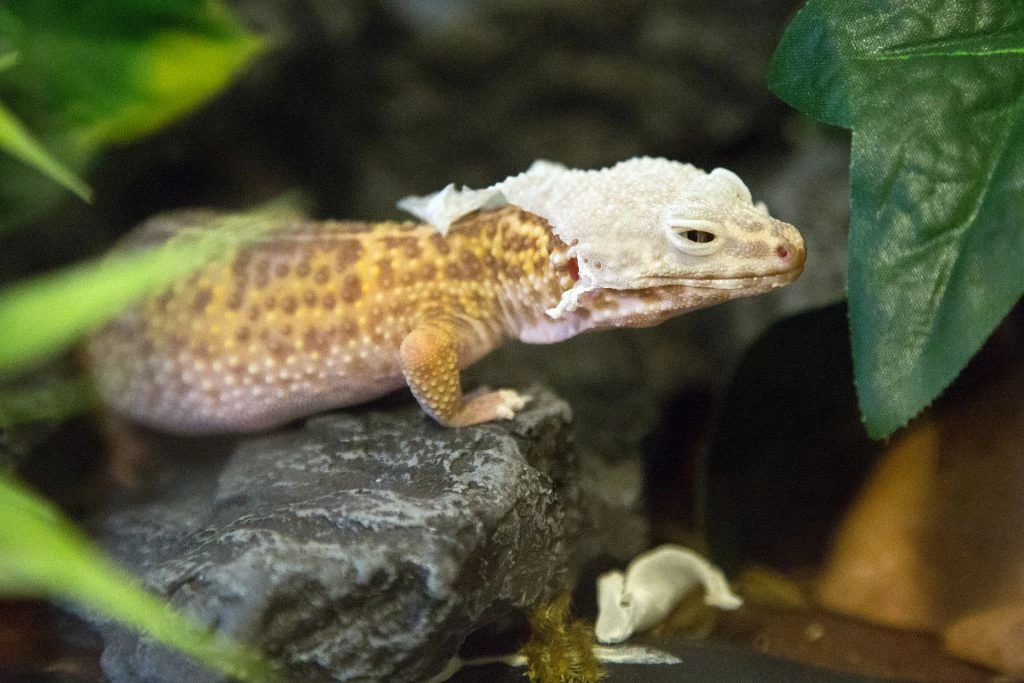
You may look out for many indications that water is absent and your leopard gecko is experiencing dehydration. It’s uncommon to notice your leopard gecko gasping when it becomes hot or dehydrated. However, here are some examples of dehydration:
- The skin becomes wrinkled, dry, and puckered.
- The elasticity of the skin deteriorates.
- Weakness and lethargy
- Having difficulty shedding
- Constipation or infrequent bowel movements
You should act promptly to rehydrate your leopard gecko if you see any of these symptoms.
Minor dehydration is simple to cure and can improve your pet fast, but severe dehydration may necessitate veterinary care and advice.
Dry Skin
One of the most noticeable signs of dehydration in leopard geckos is dry, rough skin. Leopard geckos generally have fairly soft skin, but their skin becomes rough and flaky as they lose moisture. Leopard geckos’ dry skin can be highly painful and affect their overall health.
Eyelid Issues
Only a small number of reptiles, such as leopard geckos, have movable eyelids. However, when a leopard gecko is dehydrated, its eyelids grow rough, making it difficult to move them. Further complicating matters is moisture loss in the leopard gecko’s eyes as it dehydrates.
Skin Elasticity Loss
When a leopard gecko is dehydrated, its skin loses tonicity and flexibility. Leopard geckos prefer to remain in one location and rarely move around their enclosure.
Recessed Eyes
Sunken eyes are a commonly encountered indicator of dehydration in all living creatures, including reptiles, such as leopard geckos. Dehydration causes the muscles of a leopard gecko to lose water content and reduce in size, causing the eyes to rescind into the skull sockets.
Weakness and Lethargy
If your leopard gecko is dehydrated, it will lose its motivation to eat and become significantly less active. It will be motionless and uninterested in its surroundings. If overlooked, weakness and lethargy in geckos can lead to various health issues.
Inadequate Shedding
A leopard gecko’s ability to shed its skin is essential to its growth and development. As a result of improper skin shedding, a dehydrated leopard gecko may experience other health issues.
Constipation and Digestion Issues
Like humans, leopard geckos experience constipation when thirsty. A leopard gecko’s infrequent feces might lead to the accumulation of poisons in the body.
Constipation can be exceedingly uncomfortable for leopard geckos, and it may even be fatal. It gets worse when the digestive system becomes obstructed. Dehydration can result in digestive problems with constipation in leopard geckos since they require water for healthy food digestion and the appropriate operation of their digestive system.
Dried-Up Mucous Membranes
Every orifice contains a particular kind of skin called a mucus membrane, including the mouth cavity, anus, and the region around the eyes. A leopard gecko’s mucous membranes will dry when dehydrated. The dryness of such mucous membranes can severely harm the leopard gecko’s general health.
Changes in Saliva Consistency
All body fluids, including saliva, alter consistency when a leopard gecko dehydrates. The saliva of a dehydrated leopard gecko will be quite sticky and viscous. You’ll also observe that the leopard gecko is no longer regularly licking its mouth or eyes.
Levels of Dehydration
You should treat your leopard gecko as soon as you suspect it may be dehydrated. A veterinarian should examine any dehydration symptoms. It shouldn’t be ignored because doing so could cause a torturous death. These include:
- Mild dehydration – less than 5% of the total weight of the reptile has been lost as water. You can give your leopard gecko a warm bath to assist them in retaining moisture and increase its hydration levels if they are only somewhat dehydrated.
- Moderate dehydration – 5% to 9% of the body weight of the reptile has been lost as water. The veterinarian can advise taking long baths or giving extra fluids orally if the dehydration is moderate.
- Severe dehydration – 10% to 15% of the body weight of the reptile has been lost as water. Severe dehydration is extremely serious and will be expected to treated by injecting fluids into your pet to help it obtain the fluids it requires quickly and effectively.
Your veterinarian will give you instructions, and you should strictly go by them to avoid giving the animal much more fluid at once.
Cause of Dehydration in Leopard Geckos
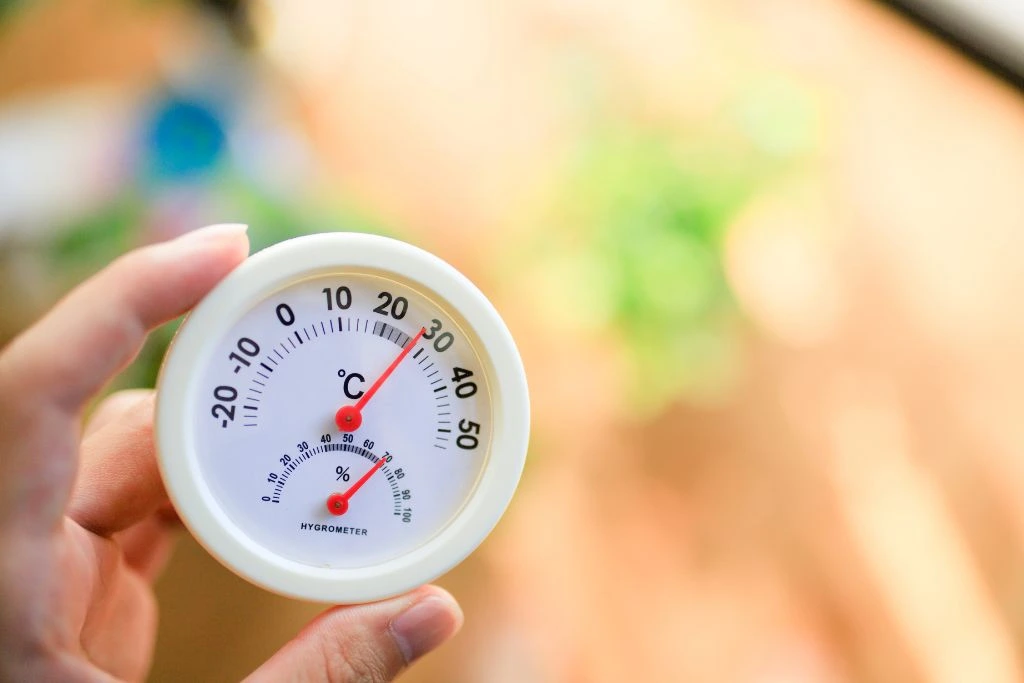
- Inappropriate tank temperatures – can cause your leopard gecko to lose water in the body and become dehydrated. Consistently high tank temperatures can also cause this.
- Inappropriate humidity levels – dehydration can quickly occur in your leopard gecko if the humidity in its tank is too low. It frequently occurs when the tank’s substrate absorbs the humidity in the air.
- Illnesses – conditions that cause your leopard gecko to vomit, have diarrhea, or refuse to eat can lead to dehydration and sometimes even weight loss.
How To Treat a Dehydrated Leopard Gecko?
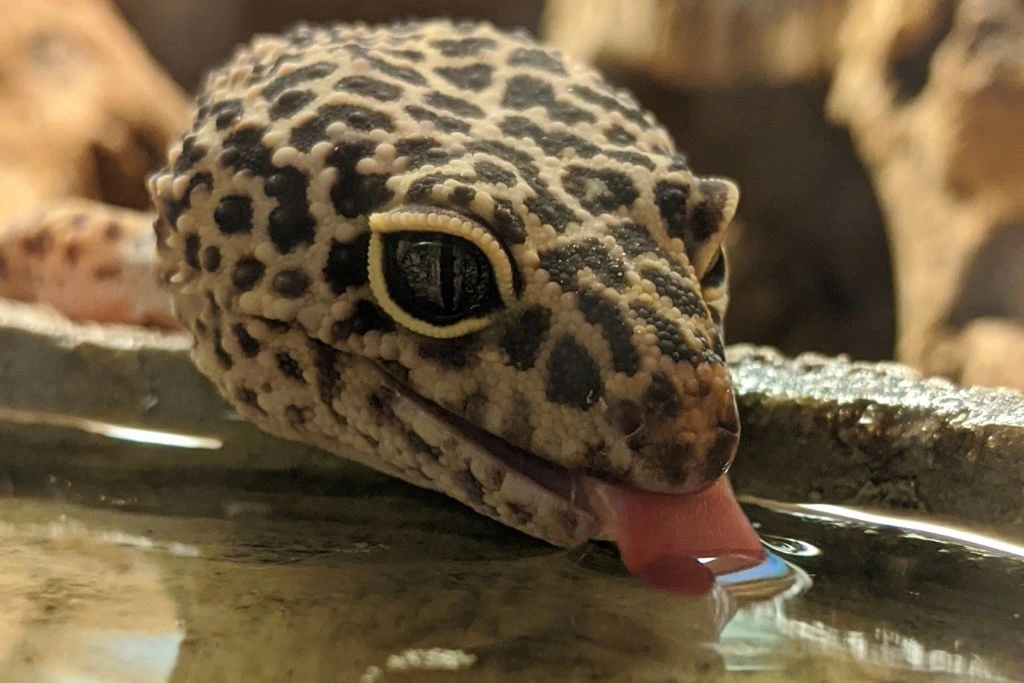
Take your leopard gecko to the vet immediately if you think it may be dehydrated. Only a trained specialist can immediately assess the degree of dehydration and provide the most effective rehydration method. Vets and other experts can assess how severely dehydrated your reptile is by calculating how much weight it has lost and performing blood tests.
Blood urinary nitrogen (BUN), packed cell volume (PCV), and total proteins (TP) tests are frequently employed for this purpose. Once the cause of your leopard gecko’s dehydration has been determined, your veterinarian may advise soaking it in lukewarm water to treat it.
They suggest misting the gecko’s tank daily and ensuring it has a water dish nearby. Mild dehydration can be reversed by giving the leopard gecko extra fluids orally or by giving it a long soak.
Injecting Fluids
If your reptile is extremely dehydrated, injecting fluids into it is the most appropriate cure. Your veterinarian might carry out this procedure or offer instructions to perform it independently. In every situation, strictly adhere to your veterinarian’s recommendations. By doing this, you’ll refrain from giving too much fluid or making the situation worse.
The fluids typically given to leopard geckos can be electrolyte solutions rather than water. Such solutions can be created using sports drinks, Pedialyte, or Ricelyte. These fluids could be delivered in addition to the ways mentioned above by:
- IO fluid administration – a technique for injecting fluids right into the bone canal of your reptile. It is often saved for reptiles who are extremely dehydrated.
To effectively care for your scaly pet, leopard gecko owners must be informed of the various causes of dehydration in leopard geckos. Leopard geckos’ primary sources of dehydration include:
- Lack of drinking water – if you provide your leopard gecko adequate water, it will stay hydrated. Ensure that the dish is always full and track its drinking patterns to determine when to increase water intake sedation beforehand. IO fluid injection can assist leopard geckos suffering from shock, severe volume depletion, and dehydration.
- Orogastric tube feeding – inserting a catheter to send fluids right into the digestive system of your leopard gecko. Clinicians can perform this procedure on a critically dehydrated reptile or one having difficulty eating.
How Do Veterinarians Determine How Much Hydration To Give to Dehydrated Leopard Geckos?
If your veterinarian determines that giving your leopard gecko fluids directly or through catheters is the best course for treating its dehydration, they must determine the proper amounts.
These experts frequently do this by giving each kilogram of gecko 10 to 30 milliliters of fluid per day. A different strategy is to give your leopard gecko fluids between 2.5% and 3.5% of its body weight daily.
You will need to administer these fluids to your leopard gecko for two to four days, regardless of the course your veterinarian takes.
Preventing Dehydration in Leopard Geckos
If you take the proper precautions, leopard geckos’ dehydration can be avoided. The first step is to make sure you keep your pet adequately hydrated to prevent dehydration from occurring in the first place.
- Bath Your Gecko – Make sure the bathing water you have given your gecko is hygienic and chemical-free, and if it still won’t dip in, lift it gently into the water twice daily and let it bathe there for a few minutes at a time. There are compelling reasons to bathe leopard geckos, other than treating dehydration or addressing skin problems.
- Provide Nutritious Fresh Food – Live food is best, but avoid dried foods because they lack the vitamins your gecko requires. Dried food needs to be wetter.
- Water Quality – The best water is bottled, rained, filtered, or distilled. If you can’t avoid it, tap water is fine, too. You can use a water conditioner to eliminate chlorine and other contaminants from tap water.
- Maintain Proper Temperature – The ideal basking temperature for a leopard gecko is between 95 to 104 degrees Fahrenheit (35 and 40 degrees Celsius), with the tank’s cold zone hovering at 71.6 to 77 degrees Fahrenheit (22 to 25 degrees Celsius) during the day. Ensure your heat bulb is off at night, but keep your tank’s temperature above 64.4 degrees Fahrenheit (18 degrees Celsius).
- UVB Light – Your gecko requires a UVB lamp with an output rating of roughly 5% to6% for general health. Leopard geckos can absorb vitamin D at a rate of 5% to 6%, improving overall health and encouraging drinking and eating.
- Supply Water – In more dire circumstances, you should buy a plastic syringe to deliver water into your gecko’s mouth. If you are doubtful, see a veterinarian.
- Mist Regularly – Geckos take water from the atmosphere, so spritz your tank with water every few days to keep it comfortably humid. Your gecko will be content if you keep the humidity between 30% and 40%.
Dehydration Risks for Leopard Geckos
Any owner of a lizard or other reptile will tell you that you must act if you discover an issue with your pet. Since reptiles are known for having slower metabolic rates than mammals when symptoms manifest, the underlying problem has probably already existed for some time.
Dehydration can result in a leopard gecko’s death if it is not treated. It would help if you comprehended the seriousness of the situation.
Acidosis
Acidosis happens when the gecko’s blood becomes more acidic and less alkaline. Organ failure often occurs when the body’s acidity is out of balance.
Uremia
Blood, nitrates, and amino acids can be discovered in an animal’s pee when its body can no longer remove poisons and waste from its system. If this continues for an extended period, the animal develops kidney failure.
How Long Can Leopard Geckos Survive in the Absence of Water?
Leopard geckos can survive without water for two to three days. They risk becoming dehydrated and perhaps dying if they persist past this point. Even if your gecko doesn’t seem interested, you should always leave a water dish in its habitat.
How To Provide a Bowl of Water to Your Leopard Gecko?
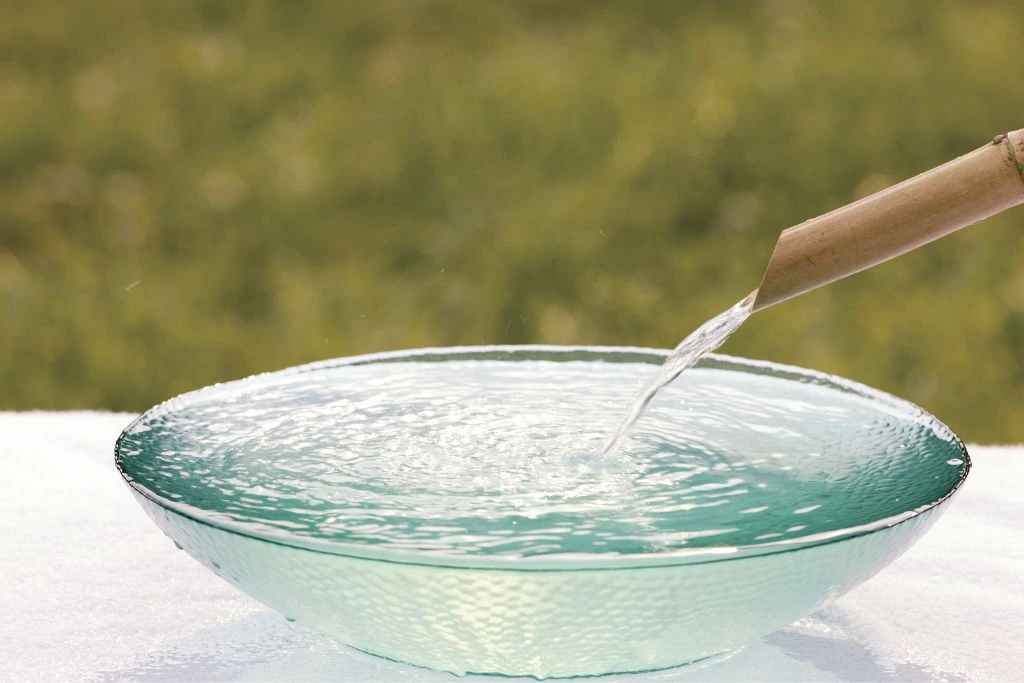
It would be best to keep a few things in mind when providing water to your leopard gecko. Make sure that every water you provide is devoid of chlorine. Leopard geckos might become ill from chlorine exposure and perhaps perish. Remember that a large yet shallow bowl prevents your leopard gecko from suffocating.
These reptiles don’t encounter much water throughout the environment, so they lack swimming skills and are susceptible to drowning. You could even put a clean pebble in the dish to entice your gecko to the water. Whatever you do, make sure the bowl is hygienic and devoid of harsh soaps because dirt and nasty chemicals can harm your gecko’s health.
Replenish the bowl with cold water daily or every other day to prevent contamination. To prevent evaporation, constantly put it on the cool side of a vivarium.
Conclusion
Dehydration is a dangerous and sometimes fatal condition in leopard geckos. Please pay attention to your leopard gecko’s behavior, posture, and other indicators mentioned above to identify whether or not your leopard gecko is dehydrated.
You shouldn’t be concerned about leopard geckos’ hydration as long as they consume insects that are high in moisture, have availability to a reservoir of water, and appear healthy. The idea that you have yet to observe them consuming out from the bowl is insufficient to cause concern.
The symptoms are typically obvious, and some are comparable to those seen by other dehydrated animals. Take your leopard gecko to the clinic and follow their recommendations if you spot indications of dehydration.

